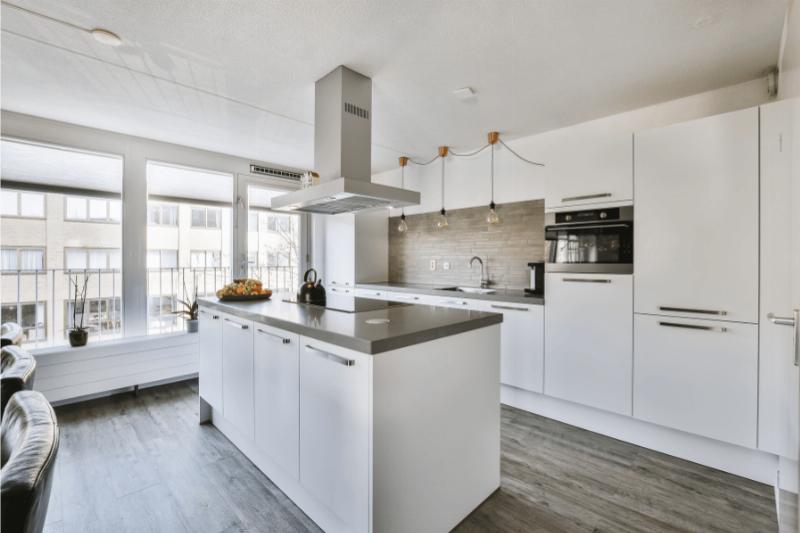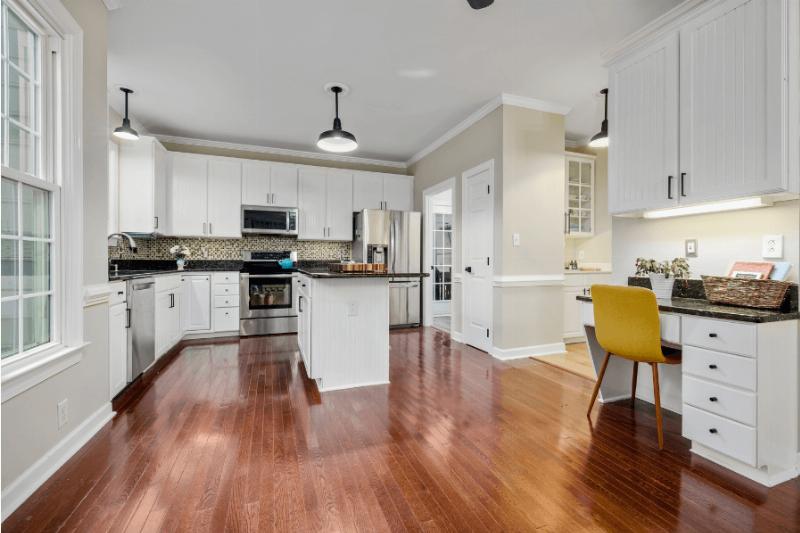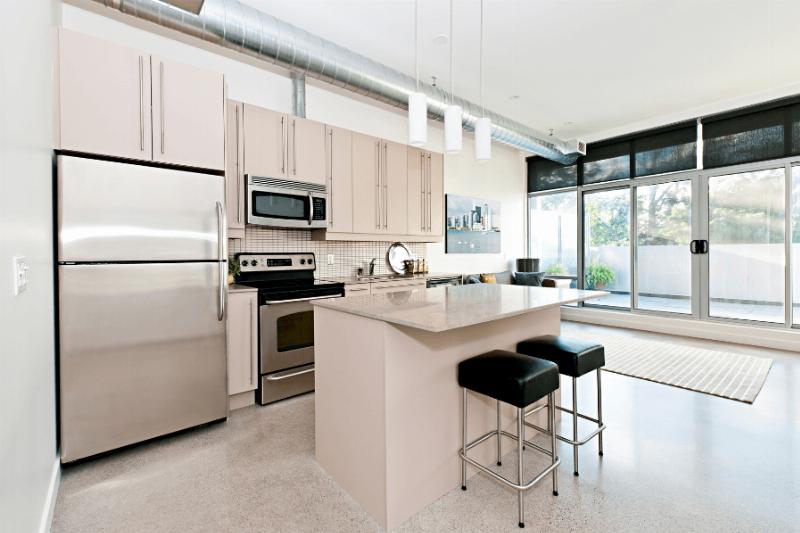Choosing the right flooring for your kitchen is crucial, considering the significant time spent in this space.
Not only do kitchen floors impact the overall look and feel of your home, but they also need to be durable enough to withstand the daily hustle and bustle. With spills, stains, and heavy foot traffic, it’s essential to opt for practical and visually appealing materials.
In this guide, we’ll explore the top seven kitchen flooring options, each selected for its durability and ability to handle the demands of a busy kitchen. We understand that flooring is an investment, so we’ll help you strike a balance between a style you love and a material that can stand the test of time.
Best Types of Kitchen Flooring

Selecting the ideal kitchen flooring largely depends on your specific requirements. However, we highly recommend considering tile as a primary choice. Below are our top suggestions:
- Concrete
- Tile
- Vinyl Plank
- Bamboo
- Brick
- Linoleum
- Cork
|
Flooring Type |
Best for |
|
Concrete |
Modern kitchens |
|
Tile |
High moisture areas |
|
Vinyl Plank |
Budget-conscious |
|
Bamboo |
Eco-friendly choices |
|
Brick |
Long-term durability |
|
Linoleum |
Retro styles |
|
Cork |
Comfort underfoot |
1. Concrete
If your home doesn’t have a basement and your kitchen is on the ground floor, concrete can be a strong and long-lasting flooring choice.
It’s not just a plain surface; you can make it look great by creatively polishing, staining, or treating it. This makes it low-maintenance and stylish, perfect for modern kitchens.
Any downside
Concrete is porous, so you need to seal it to avoid stains and water damage. It can feel stiff and cold, similar to ceramic tiles. Also, not everyone likes the urban or industrial look it gives, which might be a bit tricky when selling your home.
2. Tile
Tile is an outstanding pick for kitchen flooring due to its exceptional durability, superior water resistance, and scratch-resistant qualities. Properly grouted tiles become entirely waterproof, eliminating concerns about water damage.
Tile floors are easily maintained and cleaned, especially with quality tile cleaners. There are two main types of tile flooring: porcelain and ceramic.
Porcelain tiles, being more durable, are recommended for kitchens and are relatively cost-effective, ranging from $2 to $10 per square foot.
On the other hand, ceramic tiles, although less expensive, are more porous and softer, making them more susceptible to wear and tear. They are often preferred in warmer climates for their natural coolness.
Any downside
Tile floors can be slippery so that a non-slip mat may be necessary, especially near the sink. Additionally, sealing the grout in high-traffic areas enhances durability.
3. Vinyl Plank
Vinyl is a smart and budget-friendly choice for kitchen floors. It comes in two main types: luxury vinyl tile (LVT) and sheet vinyl. These options are durable, resist moisture, and are easy to clean—perfect for handling spills and kitchen activities.
Vinyl feels warm and soft under your feet, making it comfy for standing and cooking. Luxury vinyl planks (LVP) are trendy, giving you various looks like wood or stone at a more affordable price.
Any downside
Vinyl can scratch and might not be as challenging as some other floorings.
4. Bamboo
Bamboo is gaining popularity in kitchens due to its enhanced durability compared to traditional wood. The manufacturing process makes bamboo more resistant to moisture and water damage, making it an excellent choice for kitchen flooring.
If you desire the aesthetics of hardwood but need higher moisture resistance and durability, bamboo is a great option.
There are three main types of bamboo flooring. Strand-woven bamboo is the most robust and costly. Engineered bamboo has a layer of bamboo on top with a waterproof coating. Solid bamboo is made by bonding sliced bamboo together.
Any downside
Bamboo flooring can look different based on color, pattern, and grain. Solid bamboo may not be the best choice for kitchens with high moisture levels.
5. Brick
Using brick for your kitchen floor might sound unconventional, but brick proves to be a sturdy and enduring choice for kitchen flooring. This robust material, traditionally used in wall and flooring construction, imparts an industrial aesthetic to the home.
Brick kitchen floors boast a lengthy lifespan and exceptional durability against heat, impact damage, and abrasion. Users can have confidence in its longevity, ensuring it withstands the test of time without compromising reliability.
Any downside
Brick is porous, so it needs to be sealed regularly to prevent stains and water damage. Usually, it’s sealed when installed and needs resealing about once a year.
6. Linoleum
Linoleum is a flooring material that was popular in the 1960s and is making a comeback because it has a cool retro style. It comes in fun and funky designs that give your kitchen a nostalgic vibe. Linoleum is made from natural stuff, so it’s more eco-friendly and less polluting.
Linoleum is also affordable, ranging from $2 to $12 per square foot. So, it is excellent for those on a budget. It’s easy to care for, and you don’t need advanced installation tools.
Any downside
Linoleum can get discolored if exposed to the sun for too long and is not completely waterproof. It’s not the most challenging flooring option, especially against water, as it can curl at the edges.
7. Cork
Cork flooring is soft and comfy under your feet, making it easier on your legs when you spend a lot of time in the kitchen. It looks unique and adds to the overall style of your home.
People who want a comfy and eco-friendly flooring option. Cork is soft, budget-friendly (costs between $3 and $7 per square foot), and comes in different shapes and colors.
Any downside
Cork can get dented, scratched, and damaged by moisture. It would help if you sealed it every one to two years to protect it. It’s not the easiest to clean and might stain easily.
Considerations for Choosing Kitchen Flooring

When deciding on the right kitchen flooring, it’s crucial to consider various factors to ensure you choose the most suitable material for your home.
Durability
Consider the needs of your household members. If there are pets, young children, or individuals who tend to create messes, it’s advisable to opt for a durable and easy-to-maintain material such as vinyl flooring.
Water Resistance
Some flooring materials demand higher maintenance levels, like the regular sealing of natural stone for enhanced water resistance. If you prefer a lower-maintenance option, consider materials like hardwood or ceramic tile.
Budget
Evaluate the cost of different flooring types against your budget, keeping in mind the long-term value versus upfront costs.
Aesthetics
Take into account the style of your home and personal design preferences. Look for flooring materials that complement the overall aesthetic of your home.
Comfort
For those seeking comfort while standing in the kitchen, softer options like vinyl, linoleum, and hardwood are more forgiving than harder choices like brick and natural stone.
Installation Tips
Assess your skills and the potential savings of a DIY installation against the benefits of professional installation, such as warranty and expertise.
Prepare your subfloor and gather the necessary materials and tools before beginning the installation. Consider your living arrangements during this period, as it may disrupt your daily routine.
Do I Need Help from a Contractor?
Whether you need help from a contractor depends on the complexity of the kitchen flooring project, your expertise, and the type of flooring material you choose.
When considering the installation and repair of kitchen flooring, opting for a contractor from a distinguished remodeling company such as Smart Remodeling LLC is a wise decision.
This ensures that your project is handled with expertise and professionalism, resulting in a high-quality outcome. Choosing a contractor from a reputable remodeling company brings a host of benefits, including specialized knowledge, access to quality materials, efficient project management, and adherence to regulations.
It guarantees a smooth and well-executed process, ultimately providing you with a kitchen floor that meets your expectations and standards.
If you live in Houston, Texas, and want professional help, Contact Us Today.
The End
Selecting the best flooring for your kitchen is a decision that affects both the functionality and aesthetic appeal of your home’s central gathering place. By considering the types of flooring available, along with lifestyle, budget, and design considerations, you can make an informed choice that meets your needs and preferences.
Remember to follow proper installation and maintenance practices to ensure your kitchen floor remains beautiful and durable for years.






